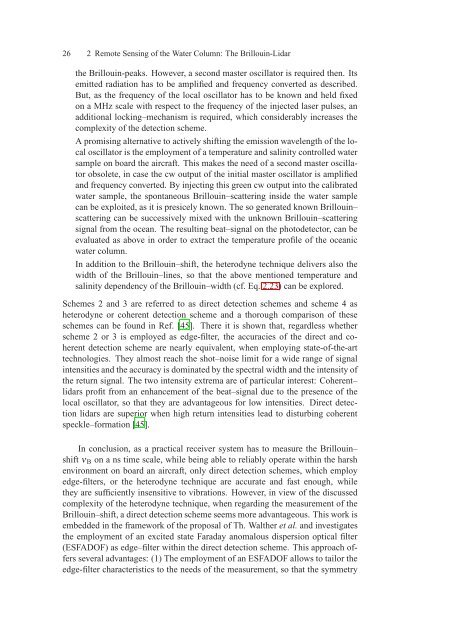Assessment of a Rubidium ESFADOF Edge-Filter as ... - tuprints
Assessment of a Rubidium ESFADOF Edge-Filter as ... - tuprints
Assessment of a Rubidium ESFADOF Edge-Filter as ... - tuprints
You also want an ePaper? Increase the reach of your titles
YUMPU automatically turns print PDFs into web optimized ePapers that Google loves.
26 2 Remote Sensing <strong>of</strong> the Water Column: The Brillouin-Lidar<br />
the Brillouin-peaks. However, a second m<strong>as</strong>ter oscillator is required then. Its<br />
emitted radiation h<strong>as</strong> to be amplified and frequency converted <strong>as</strong> described.<br />
But, <strong>as</strong> the frequency <strong>of</strong> the local oscillator h<strong>as</strong> to be known and held fixed<br />
on a MHz scale with respect to the frequency <strong>of</strong> the injected l<strong>as</strong>er pulses, an<br />
additional locking–mechanism is required, which considerably incre<strong>as</strong>es the<br />
complexity <strong>of</strong> the detection scheme.<br />
A promising alternative to actively shifting the emission wavelength <strong>of</strong> the local<br />
oscillator is the employment <strong>of</strong> a temperature and salinity controlled water<br />
sample on board the aircraft. This makes the need <strong>of</strong> a second m<strong>as</strong>ter oscillator<br />
obsolete, in c<strong>as</strong>e the cw output <strong>of</strong> the initial m<strong>as</strong>ter oscillator is amplified<br />
and frequency converted. By injecting this green cw output into the calibrated<br />
water sample, the spontaneous Brillouin–scattering inside the water sample<br />
can be exploited, <strong>as</strong> it is presicely known. The so generated known Brillouin–<br />
scattering can be successively mixed with the unknown Brillouin–scattering<br />
signal from the ocean. The resulting beat–signal on the photodetector, can be<br />
evaluated <strong>as</strong> above in order to extract the temperature pr<strong>of</strong>ile <strong>of</strong> the oceanic<br />
water column.<br />
In addition to the Brillouin–shift, the heterodyne technique delivers also the<br />
width <strong>of</strong> the Brillouin–lines, so that the above mentioned temperature and<br />
salinity dependency <strong>of</strong> the Brillouin–width (cf. Eq. 2.23) can be explored.<br />
Schemes 2 and 3 are referred to <strong>as</strong> direct detection schemes and scheme 4 <strong>as</strong><br />
heterodyne or coherent detection scheme and a thorough comparison <strong>of</strong> these<br />
schemes can be found in Ref. [45]. There it is shown that, regardless whether<br />
scheme 2 or 3 is employed <strong>as</strong> edge-filter, the accuracies <strong>of</strong> the direct and coherent<br />
detection scheme are nearly equivalent, when employing state-<strong>of</strong>-the-art<br />
technologies. They almost reach the shot–noise limit for a wide range <strong>of</strong> signal<br />
intensities and the accuracy is dominated by the spectral width and the intensity <strong>of</strong><br />
the return signal. The two intensity extrema are <strong>of</strong> particular interest: Coherent–<br />
lidars pr<strong>of</strong>it from an enhancement <strong>of</strong> the beat–signal due to the presence <strong>of</strong> the<br />
local oscillator, so that they are advantageous for low intensities. Direct detection<br />
lidars are superior when high return intensities lead to disturbing coherent<br />
speckle–formation [45].<br />
In conclusion, <strong>as</strong> a practical receiver system h<strong>as</strong> to me<strong>as</strong>ure the Brillouin–<br />
shift ν B on a ns time scale, while being able to reliably operate within the harsh<br />
environment on board an aircraft, only direct detection schemes, which employ<br />
edge-filters, or the heterodyne technique are accurate and f<strong>as</strong>t enough, while<br />
they are sufficiently insensitive to vibrations. However, in view <strong>of</strong> the discussed<br />
complexity <strong>of</strong> the heterodyne technique, when regarding the me<strong>as</strong>urement <strong>of</strong> the<br />
Brillouin–shift, a direct detection scheme seems more advantageous. This work is<br />
embedded in the framework <strong>of</strong> the proposal <strong>of</strong> Th. Walther et al. and investigates<br />
the employment <strong>of</strong> an excited state Faraday anomalous dispersion optical filter<br />
(<strong>ESFADOF</strong>) <strong>as</strong> edge–filter within the direct detection scheme. This approach <strong>of</strong>fers<br />
several advantages: (1) The employment <strong>of</strong> an <strong>ESFADOF</strong> allows to tailor the<br />
edge-filter characteristics to the needs <strong>of</strong> the me<strong>as</strong>urement, so that the symmetry
















